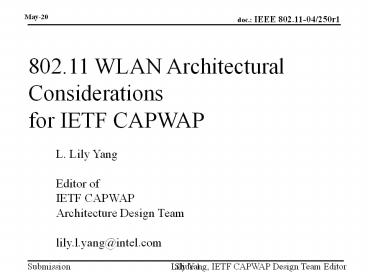802.11 WLAN Architectural Considerations for IETF CAPWAP PowerPoint PPT Presentation
Title: 802.11 WLAN Architectural Considerations for IETF CAPWAP
1
802.11 WLAN Architectural Considerations for
IETF CAPWAP
L. Lily Yang Editor of IETF CAPWAP Architecture
Design Team lily.l.yang_at_intel.com
2
Overview
- Introduction IETF CAPWAP and IEEE
- Current 802.11 standard on architecture
- Autonomous AP architecture
- Deployment problems
- Hierarchical APAC architecture
- CAPWAP architectural considerations
- Functional split continuum
- Topology
- Security
- Open questions and suggestions
- Summary
3
Introduction
- IETF CAPWAP (Control and Provisioning of Wireless
APs) - Newly chartered WG in Jan 2004
- Problem interoperability
- Co-chairs Mani, Mahalingam Dorothy Gellert
- Need close collaboration with IEEE
- Liaison Dorothy Stanley
- Technical Advisor Bob OHara
- First WG meeting in March 2004 at Seoul
- Architecture Design Team (12 members, L. Yang
Editor) - Task 802.11 architecture taxonomy
- Will be reviewed by experts from IEEE IETF
http//www.ietf.org/html.charters/capwap-charter.h
tml
4
WLAN Architecture Defined by 802.11 today
- MAC Services defined by .11
- Station Services (4)
- Distribution System Services (5)
- Other AP functions
- AP Load balancing
- Dynamic RF mgmt control
- Station Mobility support
- Better network security
Distribution System (DS)
Portal
External Network
Implementation of DS is not specified in 802.11
standard, for good reason flexibility.
5
Autonomous AP Architecture
STA 5
STA 1
STA2
STA 3
STA 4
AP
AP
AP
External Network
- Autonomous (standalone) AP fat and
self-contained AP - No explicit infrastructure support for wireless
- Each AP provides most of the WLAN functions
including distribution, integration and other
L3 services within itself.
Traditional WLAN Architecture
6
Problems in Large WLAN Deployment
- Network administration burden
- Management
- Monitoring
- Control
- Effective RF Dynamic Provisioning needs
coordination among APs - Maintaining Consistent Configuration
- Security
- Access to the network (e.g., physical security of
APs) - Rogue AP detection
One Solution Hierarchical Architecture
7
Hierarchical ArchitectureAP AC (Access
Controller)
STA 5
STA 1
STA2
STA 3
STA 4
AP
AP
AP
Access Controller (AC)
External Network
- AP AC together implements AP functions
- Advantages of AC
- centralized controller(s) gt manageability for
large networks - network wide visibility gt better coordination
across the network - Challenges
- no standard way of splitting AP functions onto AP
and AC
No interoperability
8
Split Architecture Examples
AP Functional Stack
Split AP
Split MAC
Antenna AP
Split Continuum
9
Split Implications on 802.11 MAC PHY
Split MAC
Antenna AP
- Performance implications ?
- Timing constraints gt separation constraints?
10
Network TopologyHow AP and AC are connected?
Via L3 cloud
Via L2 cloud
Directly Connected
AC
AC
AC
L3
L2
L2
router
Switch/bridge
AP
AP
AP
AP
AP
AP
AP
AP
AP
11
Inter-dependency between split architecture and
topology
topology
x
L3
?
?
x
?
x
L2
x
x
x
Direct
Split AP
Split MAC
Antenna AP
Split architecture Continuum
12
Security in CAPWAP
- CAPWAP security issues
- Mutual authentication of AP and AC
- Secure the CAPWAP segment of AP-AC
- Dependent on split architecture
AP
STA
AC
OTA security
Authentication Server
CAPWAP segment
13
Next Steps for CAPWAP
WG
Architecture Survey
Architecture Taxonomy
DT
Expert Review
IEEE IETF
AP functional Definition
IEEE
IEEE IETF
03/24
v01 April
- Functional split of AP and AC
- Design considerations
- Network topological considerations
- Security threats
- Pros and cons
- Data analysis
- Categorization
- Tradeoff of Interoperability vs. flexibility
- Recommendations
Interoperability solution
14
Open Questions Suggestions
- Issues for IEEE to ponder
- Split implications on 802.11 PHY and MAC
- Clearer AP functional definitions
- Expert review
- Future update in WNG from CAPWAP
WLAN architecture issues border on L2 L3 Need
IEEE/IETF collaboration
15
Summary
- Autonomous AP
- Hierarchical APAC
- Functional split continuum
- Topology Constraints
- Security Issues
- Update on CAPWAP WG Plan
- Issues that need attention feedback from IEEE
- Closer collaboration between IETF and IEEE

